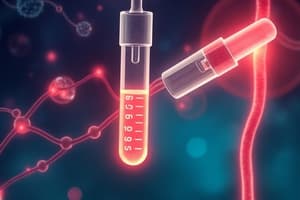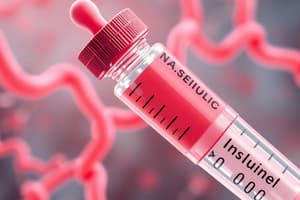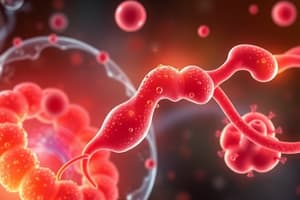Podcast
Questions and Answers
Which of the following is a requirement for accurately diagnosing Type 1 diabetes?
Which of the following is a requirement for accurately diagnosing Type 1 diabetes?
- Conduct a blood sugar test.
- Perform at least one autoantibody test.
- Have at least two autoantibody tests. (correct)
- Ensure the patient has hyperglycemia.
What is a common environmental trigger associated with the onset of Type 1 diabetes?
What is a common environmental trigger associated with the onset of Type 1 diabetes?
- Bacterial infection (correct)
- Genetic predisposition
- Inadequate nutrition
- Lifestyle choices
What is the primary treatment for individuals diagnosed with Type 1 diabetes?
What is the primary treatment for individuals diagnosed with Type 1 diabetes?
- Oral hypoglycemic agents
- Insulin therapy (correct)
- Weight management techniques
- Diet changes only
Why might not all cases of Type 1 diabetes be detected immediately?
Why might not all cases of Type 1 diabetes be detected immediately?
What is the average cost of a single autoantibody test for diagnosing Type 1 diabetes in the Philippines?
What is the average cost of a single autoantibody test for diagnosing Type 1 diabetes in the Philippines?
What is an early sign that may indicate a person will develop diabetes?
What is an early sign that may indicate a person will develop diabetes?
Which of the following factors could raise blood sugar levels in a patient with schizophrenia?
Which of the following factors could raise blood sugar levels in a patient with schizophrenia?
Which two indicators are recognized as risk factors for developing heart attack or myocardial infarction?
Which two indicators are recognized as risk factors for developing heart attack or myocardial infarction?
In the context of diabetes risk, which statement is accurate regarding PCOS?
In the context of diabetes risk, which statement is accurate regarding PCOS?
Which of the following is NOT considered a risk factor for diabetes development?
Which of the following is NOT considered a risk factor for diabetes development?
What is a primary function of insulin in muscle tissues?
What is a primary function of insulin in muscle tissues?
How does insulin affect fatty acid synthesis in adipose tissues?
How does insulin affect fatty acid synthesis in adipose tissues?
What is the consequence of insulin deficiency in terms of glucose transport?
What is the consequence of insulin deficiency in terms of glucose transport?
Which of the following processes does insulin promote in the liver?
Which of the following processes does insulin promote in the liver?
Which metabolic process is inhibited by insulin?
Which metabolic process is inhibited by insulin?
What is the primary effect of prolonged elevated blood glucose levels?
What is the primary effect of prolonged elevated blood glucose levels?
What role does insulin play concerning protein metabolism?
What role does insulin play concerning protein metabolism?
In what way does insulin primarily act as a hormone?
In what way does insulin primarily act as a hormone?
Which of the following is a macrovascular complication of diabetes?
Which of the following is a macrovascular complication of diabetes?
What type of complications can arise from continued hyperglycemia in diabetes?
What type of complications can arise from continued hyperglycemia in diabetes?
Which of the following is a possible acute complication of diabetes treatment?
Which of the following is a possible acute complication of diabetes treatment?
Which of the following factors is NOT associated with promoting diabetes complications?
Which of the following factors is NOT associated with promoting diabetes complications?
Chronic complications of diabetes typically develop over what time frame?
Chronic complications of diabetes typically develop over what time frame?
In managing diabetes, what aspect should be focused on alongside blood sugar control?
In managing diabetes, what aspect should be focused on alongside blood sugar control?
What is the leading cause of death in the Philippines related to diabetes?
What is the leading cause of death in the Philippines related to diabetes?
Which of the following is a common small vessel disease complication of diabetes?
Which of the following is a common small vessel disease complication of diabetes?
Which association between pancreatic cells and their functions is correct?
Which association between pancreatic cells and their functions is correct?
Which of the following is a sign of insulin resistance?
Which of the following is a sign of insulin resistance?
Which option can help normalize blood sugar by increasing insulin and decreasing glucagon secretion?
Which option can help normalize blood sugar by increasing insulin and decreasing glucagon secretion?
Which of the following is NOT part of the ominous octet related to diabetes?
Which of the following is NOT part of the ominous octet related to diabetes?
If the abnormality is in the muscle or adipose tissue, which treatment option is recommended?
If the abnormality is in the muscle or adipose tissue, which treatment option is recommended?
What can be indicated if hyperglycemia is linked to liver dysfunction?
What can be indicated if hyperglycemia is linked to liver dysfunction?
Among the following, which statement is true regarding insulin and glucagon secretion?
Among the following, which statement is true regarding insulin and glucagon secretion?
If the abnormality is in the pancreas, which option can be administered?
If the abnormality is in the pancreas, which option can be administered?
Flashcards are hidden until you start studying
Study Notes
Actions of Insulin in Metabolic Processes
- Insulin binds to receptors in various tissues, triggering metabolic actions.
- In muscle tissue, insulin facilitates glucose uptake, stimulates amino acid uptake, promotes protein synthesis, and prevents protein breakdown.
- In adipose tissue, insulin stimulates fatty acid and triglyceride synthesis while preventing lipolysis.
- In liver and muscle, insulin increases glycogen synthesis and inhibits glycogenolysis.
- In the liver, insulin also promotes fatty acid synthesis and prevents gluconeogenesis.
- Insulin is primarily an anabolic hormone promoting storage and synthesis of nutrients.
Diabetes Mellitus Overview
- Diabetes mellitus is a group of metabolic diseases characterized by defects in insulin secretion or action.
- Common outcome of diabetes is hyperglycemia, due to glucose transporters being inactive or absent in cell membranes.
- Persistent high blood glucose can cause long-term damage to body tissues.
Etiologic Classification of Diabetes Mellitus
- Type 1 diabetes is often not diagnosed until there is significant hyperglycemia, as many individuals initially exhibit normal blood sugar levels.
- Environmental triggers, like infections, may provoke an autoimmune response against β-cells, leading to antibody production.
- Early screening for risk factors should include family history and may reveal pre-diabetes years before full-blown diabetes develops.
- Insulin is the primary treatment for Type 1 diabetes; accurate diagnosis is necessary before initiating lifelong insulin therapy.
Clinical Features and Complications
- Women with polycystic ovary syndrome (PCOS) may show elevated serum testosterone levels and require careful management regarding diabetes risk.
- Psychotropic drugs are linked to increased insulin resistance and blood sugar levels.
- Major heart attack risk factors include elevated waist circumference and waist-hip ratio.
- Complications of diabetes can be acute (e.g., diabetic ketoacidosis) or chronic (e.g., vascular diseases) and result from prolonged hyperglycemia.
Factors Promoting Diabetes Complications
- Complications arise not solely from hyperglycemia, but also associated conditions like hypertension and dyslipidemia.
- Treatment should address not only blood sugar management but also correction of contributing factors shaping the patient’s overall health.
Targeted Treatment Options
- Treatment strategies may depend on the site of pathology (liver, muscle, adipose, or pancreas).
- Metformin or thiazolidinediones (like Pioglitazone) are used for liver issues; thiazolidinediones are preferred for muscle/adipose abnormalities.
- SGLT-2 inhibitors can be beneficial for kidney-related issues.
- In cases related to pancreatic function, use of insulin, incretins, or GLP-1 receptor agonists is indicated.
- Availability of certain medications may vary by region, affecting treatment options in the Philippines.
Studying That Suits You
Use AI to generate personalized quizzes and flashcards to suit your learning preferences.





